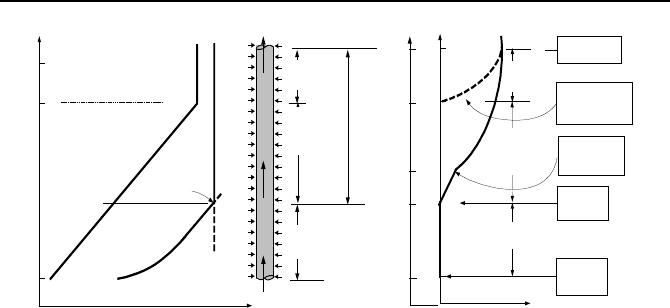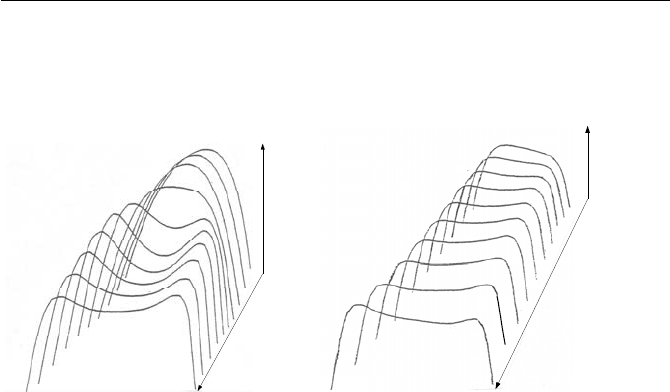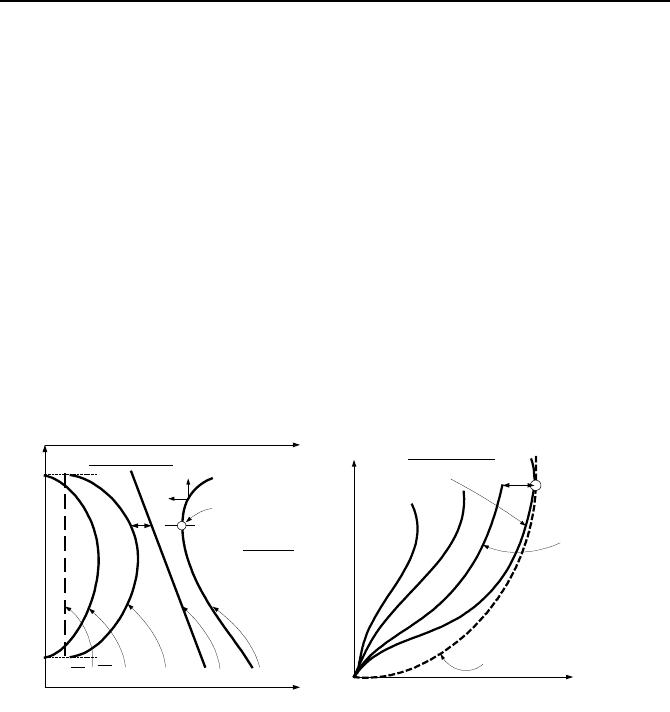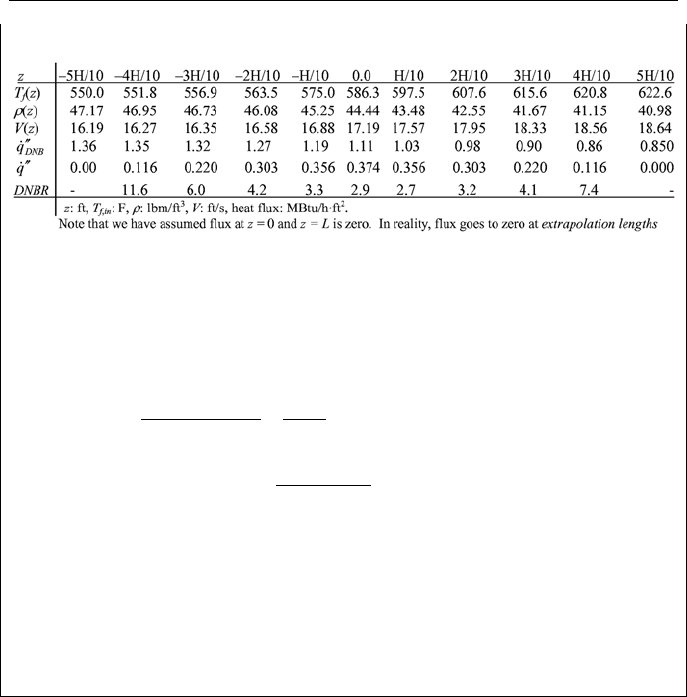Massoud M. Engineering Thermofluids: Thermodynamics, Fluid Mechanics, and Heat Transfer
Подождите немного. Документ загружается.


872 VIe. Applications: Nuclear Heat Generation
T
SB
= T
sat
+ (T
C2
− T
sat
)
J-L
– )/( hq
′′
VIe.3.13
where (
∆T
sat
)
J-L
is given by the Jens-Lottes correlation, for example:
()
900/
4/1
2
6E1/60
P
satC
e
q
TT
′′
=−
In British units, P is in psia, temperatures are in F, q
′′
is in Btu/h·ft
2
and h is in
Btu/h·ft
2
·F. In general, the heat flux is given as a function of elevation, based on
()
H/cos
max
zqq
π
′′′
=
′′′
, where the clad surface temperature is given by Equation
VIe.3.9. Thus, T
SB
= T
C2
and Z
SB
are found by solving Equations VIe.3.9 and
VIe.3.13 simultaneously. We may solve the resultant set by plotting each equa-
tion and finding the intersection. Or we set these equations equal and solve the re-
sultant nonlinear equation by numerical means. Using the second method, the
equation becomes:
¸
¹
·
¨
©
§
′′′
+
»
¼
º
«
¬
ª
¸
¹
·
¨
©
§
+
′′′
+
H
cos
PH
sin1
V
2
maxmax
,
z
h
Aq
z
cm
q
T
C
F
p
F
inf
ππ
π
=
T
sat
+
()
900/
4/1
6E1/60
P
e
q
′′
–
h
q
′′
We now substitute for q
′′
=
()()
H/cosP/
2max
zAq
CF
π
′′′
and rearrange the above
relation to get:
λ
1
Y –
λ
2
(1 – Y
2
)
1/2
–
λ
3
Y
1/4
+
λ
4
= 0
where, in this relation, Y = cos(
π
z/H), and coefficients
λ
1
through
λ
4
are given as
λ
1
= 2(A
F
/P
C2
)
max
q
′′′
/h,
λ
2
=
max
q
′′′
V
F
/(
π
c
p
m
),
λ
3
= 60[(A
F
/P
C2
)
max
q
′′′
/1E6]
1/4
/e
P/900
,
and
λ
4
= T
f,in
+
λ
2
– T
sat
.
Example VIe.3.5. Water enters the hot channel of a BWR at a velocity of V = 8
ft/s, temperature of 525 F, and pressure of 1020 psia. Fuel rods are arranged in
square array on a pitch of 0.738 in. Heat flux can be closely represented as
)12/cos(
max
zqq
π
′′
=
′′
where z is in ft. Find the clad temperature and its location
of the inception of subcooled boiling. Data: 7E28.1
max
=
′′′
q
Btu/h·ft
3
, d
C2
=
0.563 in and d
F
= 0.487 in.
Solution: At 1020 psia & 525 F,
ρ
= 47.6 lbm/ft
3
, c
p
= 1.24 Btu/lbm·F,
µ
= 6.6E-
5 lbm·ft/s, k = 0.3 Btu/h·ft·F
A
F
=
π
2
F
d /4 =
π
(0.487)
2
/4 = 1.293E-3 ft
2
, P
C2
=
π
d
C2
ҏ= 0.147 ft, V
F
= A
F
H =
1.293E-3 × 12 = 0.0155 ft
3

3. Determination of Neutron Flux in an Infinite Cylindrical Core 873
A
Flow
= p
2
–
π
2
2C
d /4 = (0.738/12)
2
–
π
(0.563)
2
/4 = 2.05E-3 ft
2
(1.9 cm
2
)
D
e
= 4A
Flow
/P
C2
= 4 × 2.05E-3/(
π
× 0.563/12) = 5.58E-2 ft (1.7 cm)
m
=
ρ
× V × A
Flow
= 47.6 × 8 × 2.05E-3 = 0.78 lbm/s = 2810 lbm/h (0.354 kg/s)
Calculate h from Equation IVb.3.6 for forced single phase flow:
C = 0.042(0.7382/0.563) – 0.024 = 0.031
Nu = hD
e
/k
Water
= 0.031Re
0.8
Pr
1/3
= 0.031[47.6 × 8 × 5.58E-2/6.6E-5]
0.8
(0.873)
1/3
= 754
Hence, h = 754 × 0.3377/5.58E-2 = 4563 Btu/h⋅ft
2
⋅F (25.91 kW/m
2
⋅K)
λ
1
= 2(A
F
/P
C2
)
max
q
′′′
/h = 2(1.293E-3/0.147) × 1.28E7/4563 = 49.35 F (9.6 C)
λ
2
=
max
q
′′
V
F
/(
π
c
p
m
) = 1.28E7 × 0.0155/(
π
× 1.24 × 2810) = 18.12 F (–7.7 C)
λ
3
= 60[(A
F
/P
C2
)
max
q
′′′
/1E6]
1/4
/e
P/900
= 60(8.78E-3 × 1.28E7/1E6)
1/4
/e
1020/900
= 11.18
F (–11.56 C)
λ
4
= T
f,in
+ C
2
– T
sat
= 525 + 18.12 – 546.99 = –3.87 F (–15.63 C)
49.35`Y – 18.12(1 – Y
2
)
1/2
– 11.18Y
1/4
– 3.87 = 0
By iteration we find Y = cos(
π
z/H) = 0.5732
Hence, z
SB
= –44 in (i.e., 44 in below the core centerline or (144/2) – 44 = 28 in
from the core inlet). Upon substitution in either Equation VIe.3.9 or VIe.3.12, we
find T
SB
= 542.4 F (283.5 C). Note, T
sat
(1020 psia) = 547 F (286 C).
In the above example we determined incipient boiling in a BWR. Let us now
investigate a similar question for a PWR. Although there is no bulk boiling under
normal operation, during certain transients or for the hot-channel even at steady
state, local boiling may take place. While PWR channels are interconnected and
heat flux profile is not uniform, we still consider fluid flow in a single vertical
channel, subject to uniform heating to characterize flow in a PWR hot channel.
For this channel, the temperature profiles of water and of channel surface as well
as the void fraction profile versus the flow quality, X are shown in Figure VIe.3.4.
Water enters this heated channel and flows upward. Heat transfer takes place
from the channel wall to the single phase water in forced convection. Somewhere
along the channel, at the point of the incipient boiling, the first bubble appears. As
discussed in Chapter Vb, the surface temperature would remain nearly unchanged
subsequent to the inception of subcooled boiling. The bubbles eventually manage
to leave the surface, migrate into the bulk liquid, and collapse to heat up water,
which is eventually brought to saturation.

874 VIe. Applications: Nuclear Heat Generation
α
X
X
in
X
o
Bulk
Boiling
Subcooled
Boiling
Single Phase
Bubble
Detachment
T
f
T
c2
T
sat
T
c
2
T
SB
T
X
X
in
X
o
X = 0
Incipient
Boiling
0.0
Subcooled
Boiling
Nucleate Boiling
Thermodynamic
Equilibrium
Channel
Inlet
Channel Exit
z
Z
o
Z
B
Z
in
Z
D
Z
NB
Single
Phase
Bulk
Boiling
Figure VIe.3.4. Incipient boiling and void-quality profile for uniform heating of water
As the void-flow quality profile of Figure VIe.3.4 indicates, void fraction re-
main zero as long as water remains subcooled. At the incipient boiling, void frac-
tion becomes nonzero and rises steadily. Upon more vigorous bubble production,
which then results in bubble detachment, the increase in void fraction occurs at a
larger slope, which continues up to the channel exit. The dotted curve shows void
fraction starting from X = 0, which conforms to the assumption of thermodynamic
equilibrium.
3.3. Margin for Thermal Design
Nuclear peaking factors. We derived the nuclear peaking factor, F
N
in Equa-
tion VIe.3.7 for a right circular cylinder core using assemblies that produce equal
power and are distributed uniformly in the core. These peaking factors are shown
in Table VIe.3.1 for various core geometries. Equation VIe.3.3 shows that the
maximum heat flux for a set of operational conditions is a fixed value and to in-
crease the core average heat flux, we must reduce the nuclear peaking factors.
Thus, for the same
max
q
′′′
, the flatter the neutron flux, the smaller the nuclear peak-
ing factors and the larger the core average heat flux. In practice, there are various
means of flattening the neutron flux in the core. For example, to flatten the radial
distribution of neutron flux, fuel assemblies with higher enrichment are placed in
the core periphery and less enriched assemblies in the center of the core. Instead
of using higher enrichment, we may place older assemblies closer to the center
and fresh assemblies in the core periphery during the plant scheduled shutdown
for reload. The same goal may also be achieved by using burnable poisons or
chemical shim (neutron absorbing material such as boron). However, placing
higher enrichment or fresh assemblies at the core periphery would also increase
neutron leakage. In the axial direction, fuel rods are loaded with less enriched fuel
or even fuel mixed with burnable poison in the center of the rod. Figure VIe.3.5
shows two axial distributions. Figure VIe.3.5(a) shows the flux profile with cosine
distribution at the beginning of cycle (BOC) and dipping in the central region to-

3. Determination of Neutron Flux in an Infinite Cylindrical Core 875
wards the end of cycle (EOC) due to higher flux. Figure VIe.3.5(b) shows the ef-
fect of burnable poison on flattening the neutron flux profile, hence, reducing the
axial peaking factor.
Power
B
u
r
n
u
p
E
O
C
B
O
C
H
/
2
-
H
/
2
H/2
-H/2
EOC
BOC
B
u
r
n
u
p
Power
(a) (b)
Figure VIe.3.5. Axial power distribution (a) Uniformly loaded rod and (b) rod loaded with
poison
Engineering peaking factors, F
E
, enhance the total peaking factor, F = F
N
×
F
E
and further reduce the core average heat flux. The engineering peaking factors
are those that affect the temperatures of clad and fuel centerline. These can be
easily identified from Equations VIe.3.9 through VIe.3.12 as follows:
– channel flow rate (
m
). Reduction in flow rate to the central channel increases
bulk temperature.
– heat transfer coefficient (h). Reduction in flow rate would adversely affect h
through the Reynolds number.
– clad thickness (d
C2
– d
C1
). Increase in clad thickness increases thermal resis-
tance to the flow of heat
– pellet diameter (d
F2
). Larger fuel diameter than nominal increases pellet/clad
interaction.
– gap heat transfer coefficient (h
G
). Reduction in h
G
increases thermal resistance
to the flow of heat.
– clad thermal conductivity (k
C
). Reduction in k
C
increases thermal resistance to
the flow of heat.
– fuel thermal conductivity (k
F
). Reduction in k
F
increases thermal resistance to
the flow of heat.
– fuel density. Increase in fuel density increases neutron flux, hence, the linear
heat generation rate.
Examples for such engineering sub-factors include: heat flux; 1.03, hot channel;
1.02, rod bowing; 1.065, axial fuel densification; 1.002, and azimuth power tilt;

876 VIe. Applications: Nuclear Heat Generation
1.03. The engineering peaking factors are primarily due to the manufacturing tol-
erances resulting in the finished product slightly deviating from the specified
nominal value. The deviation from the nominal is a probabilistic event. Hence,
the deviation can be higher or lower than the nominal value. However, to be con-
servative, we may consider only deviations that result in undesirable outcome. In
this case, deviations that result in the fuel rod temperature to increase. For exam-
ple, for the specified nominal value of 0.42 for clad outside diameter, the finished
product may be d
C2
= 0.42 ± 0.005 inch. It is conservative to use d
C2
= 0.425 in.
We may calculate the engineering peaking factor F
E
from the various peaking
sub-factors (itemized above) in two ways. The most conservative method is to as-
sume that all sub-factors occur for the most limiting, or the hottest channel.
Mathematically, this is equivalent to:
"
×××××=
FCFC
k
E
k
E
d
E
d
E
m
EE
FFFFFF
22
In this method, F
E
is a maximum, q
′′
is a minimum, and, economically, the op-
eration of the reactor is least desirable. Obviously, such a doomsday scenario
does not occur in practice. A reasonable way to account for all the engineering
sub-factors is to use a method based on statistical combination of uncertainties.
Transient peaking factors. So far, we discussed nuclear and engineering
peaking factors. These are applicable when plant is operating at steady state con-
dition and producing nominal power. Two more sets of peaking factors are also
considered. The first sub-factor (F
P
), accounts for deviations from nominal power
during normal operation and second peaking sub-factor (F
T
) accounts for such
conditions as the build up of thermal stresses in the clad due to plant transients.
The result is to further increase the safety factor:
TPEN
FFFFF ×××=
Figure VIe.3.7 shows the effect of various peaking factors on core heat flux. In
addition to the above mentioned factors, we need to consider another safety factor
to provide margin to the critical heat flux as discussed next.
Axial, Radial, Engineering Uncertainty, Overpower & Transients
Axial, Radial, Engineering Uncertainty & Overpower Factor
Axial, Radial & Engineering Uncertainty
Axial & Radial Peaking Factors
Axial Peaking Factor
Nominal Value for Core Averaged Heat Flux At Steady-state Condition
q
′′
Figure VIe.3.7. Determination of peaking factors for reactor thermal design (Todreas)

4. Reactor Thermal Design 877
4. Reactor Thermal Design
In the design of a power plant, many aspects must be evaluated and several con-
straints must be met. Some of the aspects that must be evaluated include federal,
state, and local regulations, economical and environmental considerations, site
suitability, structural, electrical, thermal, and hydraulic constraints. Focusing only
on the thermalhydraulics of a water-cooled nuclear power plant, we start from the
electric power demand that should be met by the utility. The balance of plant is
designed based on the demand on the electric grid. This design consists of the
steam cycle including turbine, steam extraction, feedwater heaters, and other heat
exchangers. The site selected for the power plant determines the ultimate heat
sink. If located on sites close to a bay, a lake, or other large bodies of water,
selection of a condenser is warranted. Otherwise, cooling ponds or cooling towers
should be used. If a condenser is used, the appropriate condensate pumps and con-
densate booster pumps to provide the design head and flow rate must be selected.
This is also applied to such other pumps as the main feedwater and the feedwater
heater pump.
Channel
q
′′
q
′′
z
H/2
-H/2
PWR CORE DNBR
Core
q
′′
CHF
q
′′
MDNBR
Chann
e
q
′′
CH
F
q
′′
DNBR
=
max
q
′′
DNBR
z
x
L
B
x
Critical
= f(L
B
)
Heat
Balance at
Operating
Power
Heat Balance at
Critical Power
∆x
o
BWR Core
1
q
′′
2
q
′′
Critical
q
′′
(a) (b)
Figure VIe.4.1. Determination of CHFR in (a) PWRs and (b) BWRs
The selection of the steam supply system is the most crucial decision. For nu-
clear plants the choice in the United States is primarily between a PWR or a BWR,
although, gas cooled reactors may also be an alternative. To determine the re-
quired thermal power of the reactor core, we need to first calculate thermal effi-
ciency of the steam cycle. Having thermal efficiency, we then design the core.
It is important to note that according to Carnot’s efficiency, Equation IIa.9.2,
the higher the heat source temperature, the higher the thermal efficiency. In
BWRs, this is the core exit temperature and in PWRs this is the steam temperature
in the steam dome. The highest temperature, being directly related to the integrity
of the fuel rods, must remain well below the melting temperature of the cladding
metal. The Code of Federal Regulations (10 CFR 50-46) requires the peak clad
temperature not to exceed 2200 F (1500 K) during design basis events, as de-
scribed later in this Chapter. If a nuclear reactor was a temperature-controlled sys-

878 VIe. Applications: Nuclear Heat Generation
tem, we could have defined a safety factor for the maximum temperature and op-
erate the plant such that temperature does not exceed the calculated value. How-
ever, as Equation VIe.3.2 shows, reactors are flux-controlled systems. In such
systems as Figure VIe.4.1 shows, the CHF point must not be approached since
temperature jumps from the value corresponding to nucleate boiling to the ele-
vated value corresponding to the film-boiling region. Thus, to ensure fuel rod
temperature remains below limit, a regulatory approved correlation is first used to
calculate critical heat flux. A safety factor, F
CHF
, is then applied for conservatism.
This safety factor is the critical heat flux ratio (CHFR).
The CHF in PWRs is due to the departure from nucleate boiling (DNB), which
is a local phenomenon. Therefore, in PWRs this safety factor is referred to as the
DNBR (departure from nucleate boiling ratio). To demonstrate this graphically,
let’s evaluate the plots of Figure VIe.4.1(a). The dashed line shows the core aver-
age heat flux. Note that the core average heat flux is related to the fuel rod surface
area according to:
()
η
rodFrodF
av
N
W
N
Q
q
HPHP
==
′′
VIe.4.1
where
W
is the required power on the grid (MWe),
η
/WQ
=
is core thermal
power (MWth), and
η
is plant thermal efficiency. The first cosine curve in Figure
VIe.4.1(a) shows the axial heat flux distribution in an average channel. The sec-
ond cosine curve shows the axial heat flux distribution in the hot channel. Note
that, similar to Equation VIe.3.7 and from our earlier discussion, the relationship
between heat flux in an average channel to the heat flux in the hot channel is in the
form of:
F
q
q
av
max
′′
=
′′
VIe.4.2
In Figure VIe.4.1(a),
q
′′
is followed by the axial critical heat flux distribution,
)(zq
CHF
′′
. The last curve on the right side shows the plot of:
)H/cos(
)(
)(
max
zq
zq
zDNBR
CHF
π
′′
′′
=
which is the departure from nucleate boiling ratios for various points along the hot
channel. The minimum point on this plot is the minimum departure from nucleate
boiling ratio, MDNBR:
)H/cos(
)(
max DNB
DNBCHF
zq
zq
MDNBR
π
′′
′′
=
VIe.4.3
If we substitute from Equation VIe.4.3 into Equation VIe.4.2 and subsequently in
Equation VIe.4.1, we find:

4. Reactor Thermal Design 879
()
)(HP
)H/cos(
DNBCHFF
DNB
rod
zq
W
MDNBRF
z
N
′′
××
»
¼
º
«
¬
ª
=
η
π
VIe.4.4
Equation VIe.4.4 shows the intricate relationship between power production, hot
channel factor, and the minimum departure from nucleate boiling ratio. Economi-
cally, for the same core design parameters, higher power is obtained when the
MDNBR and the hot channel factor are minimized.
Example VIe.4.1. The axial power distribution in a PWR core is represented as
()
12/cos zCq
π
=
′′′
where z is in ft. Use the given data and the Bernath correla-
tion for CHF to find the MDNBR.
Data:
core
Q
= 2700 MWth, P = 2250 psia (15.5 MPa), T
f,in
= 550 F (560.7 K),
core
m
= 138.5E6 lbm/h (62.82 kg/h), N
Rod
= 38,000, H
core
= 12 ft (3.66 m), d
F
=
0.38 in (0.96 cm), d
C1
= 0.39 in (0.99 cm), d
C2
= 0.45 in (1.14 cm), s = 0.588 in
(1.493 cm), c
p
= 1.3 Btu/lbm·F (5.44 kJ/kg·K), N
Rod
= 38,000.
Solution: Find
max
q
′′′
=
¸
¸
¹
·
¨
¨
©
§
Rrod
dcore
EaN
EQ
2
H
16.1
=
2
1.16 2700 3412, 000 180
12 (0.38 / 2 12) 38,000 200
×× ×
××××
=
84.13E6 Btu/h·ft
3
(870.7 MW/m
3
)
()
=
′′′
=
′′′
3/2
maxmax
qq
actual
56E6 Btu/h·ft
3
(579.6 MW/m
3
)
A
F
= 4/
2
F
d
π
= 7.87E-4 ft
2
. We also find the channel flow area A
Flow
= s
2
–
4/
2
2C
d
π
= 1.296E-3 ft
2
(1.2 cm
2
)
D
e
= 4A
Flow
/P
C2
= 4 × 1.296E-3/(
π
× 0.45/12) = 0.044 ft (1.34 cm)
38000/6E5.135=m
= 3565.8 lbm/h (0.45 kg/s)
)(zq
′′
=
()
()
H/cos4/
max2
2
zqdd
CF
π
′′′
= [(0.38/12)
2
/(4 × 0.45/12)] × 56E6
cos(
π
z/H) = 0.374E6 cos(
π
z/H)
»
¼
º
«
¬
ª
¸
¹
·
¨
©
§
+
′′′
+=
H
sin1
H
)(
max
,
z
cm
Aq
TzT
p
F
inff
π
π
=
550 +
»
¼
º
«
¬
ª
¸
¹
·
¨
©
§
+
××
×−×
H
sin1
3.18.3565
124E87.76E56
z
π
π
= 550 +
»
¼
º
«
¬
ª
¸
¹
·
¨
©
§
+
H
sin136
z
π

880 VIe. Applications: Nuclear Heat Generation
We now set up the following table for the hot channel in the core:
where
DNB
q
′′
is calculated from:
(
)
fCHFsCHFCHF
TThq −=
′′
,
In this equation, h
CHF
and T
s,CHF
are obtained from (the Bernoth correlation):
6.0
48
)/P(1
1
890,10
e
eh
CHF
D
V
D
h
+
+
=
π
and
V
P
PT
CHFs
45.0
)/15(1
2.97
ln6.10232
,
−
+
−+=
, respectively.
More accurate results are obtained if we use smaller increments from z = 0.0 to z =
2H/10. According to the Bernath correlation, the MDNBR = 2.7. Expectedly, the
determination of the MDNBR strongly depends on the correlation used to predict
CHF in the hot channel. Note that we ignored small changes in pressure due to
friction, elevation, and acceleration pressure drops. In this table, water tempera-
ture at each node is calculated from Equation VIe.3.9, which is used in turn to find
water density and to obtain water velocity in the channel from Equation IIa.5.2.
As discussed in Chapter Vb, the critical heat flux in BWRs is due to the total
heat deposited in the channel resulting in an annular flow regime and eventually
leading to dryout. For this reason, in BWRs the CHFR is referred to as the critical
power ratio, CPR. Shown in Figure VIe.4(b), the first curve on the left side is the
flux distribution in a channel. The second shows the increased heat flux from
1
q
′′
to
2
q
′′
. We may keep increasing the heat flux and obtaining similar curves. The
third plot, for example, shows the curve corresponding to the normal operational
condition. The heat flux may be further increased so that the corresponding curve
is tangent to the curve representing the critical condition. This is the limiting
power that must not be approached. The curve representing CHF, in terms of
critical quality versus boiling length, is known as GEXL and is obtained by Gen-
eral Electric (GE) from proprietary data.

4. Reactor Thermal Design 881
Example VIe.4.2. The axial power distribution in a PWR core is represented as
()
12/cos
max
zqq
π
′′′
=
′′′
where z is in ft. The core active length is 12 ft. The
MDNBR of 2.0 occurs 20 inches from the core mid-plane where the critical heat
flux is calculated as 1.2E6 Btu/h·ft
2
. Find a)
max
q
′′
, b)
av
q
′′
, and c) total fuel rod
surface area. Data: Hot channel factor: 2.8, Required power on grid: 1000 MWe,
η
= 29%.
Solution: We find the heat flux profile from q
′′′
profile since
2
(/4)H
F
qd
π
=
′′′
2
()H
C
qd
π
′′
. Therefore, we find qq
′′′
=
′′
(A
F
/P
C2
) where A
F
and P are the fuel
cross sectional area and perimeter, respectively. The heat flux profile becomes:
()
¸
¹
·
¨
©
§
′′
=
¸
¹
·
¨
©
§
′′′
=
′′
12
cos
12
cosP/)(
maxmax2
z
q
z
qAzq
CF
ππ
a) The maximum heat flux is found from the fact that at z = 20 in, MDNBR = 2.0
000,600
2.0
6E2.1
144
20
cos)20(
max
==
′′
=
¸
¹
·
¨
©
§
′′
=
′′
MDNBR
q
qq
CHF
π
Btu/h·ft
2
Therefore, the maximum heat flux is found as,
75.662026
906.0
000,600
)144/20cos(
000,600
max
===
′′
π
q
Btu/h·ft
2
b) The average heat flux is found as 438,236
2.8
75.026,662
max
==
′′
=
′′
F
q
q
av
Btu/h·ft
2
.
c) The required surface area is found from,
avCore
qQA
′′
=
/ where
)/(
thCore
WQ
η
= . Hence, we find total fuel rod surface area from A = (1000 ×
3412,000/0.29)/236,438 = 50,000 ft
2
.
Example VIe.4.3. Use the following data and plot the temperature profile of wa-
ter in a PWR.
Data: 2700=Q
MWth, =
Core
m
138E6 lbm/h, T
CL
= 550 F, T
FW
= 430 F, P
Core
=
2250 psia, P
SG
= 900 psia, P
Condenser
= 1 psia, =
SinkHeat
m
lbm/h, d
C2
= 0.45 in,
H
Core
= 12 ft, F = 2.5, T
sink,in
= 70 F, and T
sink,o
= 80 F.
Solution: To find the plant temperature profile, we assume pipe runs are fully in-
sulated. Then find
– core exit temperature by applying Equation IIa.6.6 to the core:
h
e
= h
i
+ ( mQ
/ ) = 547.15 + (2700 × 3412000/138E6) = 614 Btu/lbm
